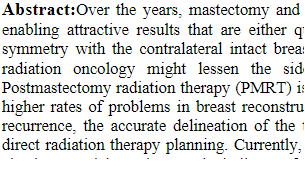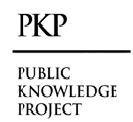Radiotherapy, Radiation Boost, Dose and Fractionation, Breast Cancer: Physiological Risks of Radiation Treatment
Keywords:
Radiation Boost, Dose and Fractionation, Breast Cancer, Radiation TreatmentAbstract
Over the years, mastectomy and reconstructive techniques have been improved, enabling attractive results that are either quite similar to the natural breast shape and in symmetry with the contralateral intact breast, or even better. In a same vein, advances in radiation oncology might lessen the side effects of treatment and enhance results. Postmastectomy radiation therapy (PMRT) is linked, however, to worse cosmetic results and higher rates of problems in breast reconstruction patients. The disease stage, the chance of recurrence, the accurate delineation of the target volumes, and the treatment goals should direct radiation therapy planning. Currently, target volume delineation for breast cancer and elective nodal volumes—including after rapid reconstruction—is supported by recommendations from the European Society for Radiotherapy and Oncology (ESTRO). Reduced radiation-induced toxicity is mostly dependent on accurate target volume delineation, careful radiation planning, total dose and fractionation, dose homogeneity, and doses to organs at risk (OAR). Different groups are currently working very hard to enhance cosmetic results in breast cancer patients who are suitable for radiation therapy and mastectomy without sacrificing their medical outcomes. One of the significant late consequences of radiation therapy, radiation-induced second malignancies (RISM), affects the best course of treatment decisions. Age at radiation, dose and volume of irradiated area, kind of irradiated organ and tissue, radiation technique, and personal and family history of cancer are only a few of the many variables that lead to the development of RISM. Unknown is the precise mechanism of RISM. But now days, with more cancer survivors, it is a developing worry in oncology, and attempts are being done to avoid or reduce the prevalence of RISM
Downloads

Downloads
Published
How to Cite
Issue
Section
License

This work is licensed under a Creative Commons Attribution 4.0 International License.
Current Clinical and Medical Education













